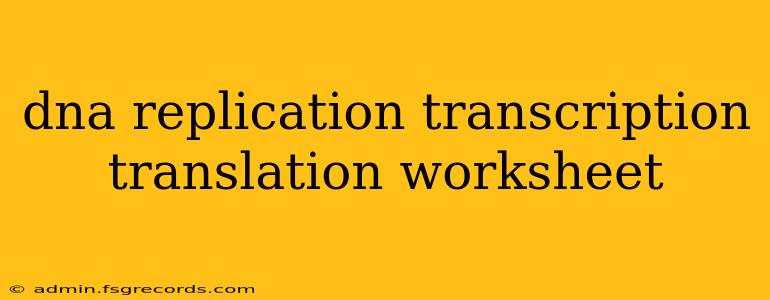This worksheet provides a comprehensive overview of DNA replication, transcription, and translation—the central dogma of molecular biology. Understanding these processes is fundamental to grasping how genetic information is stored, accessed, and used by living organisms. We'll break down each step, clarifying key concepts and providing opportunities for self-assessment.
Section 1: DNA Replication
1.1 What is DNA Replication?
DNA replication is the process by which a double-stranded DNA molecule is copied to produce two identical DNA molecules. This ensures that genetic information is accurately passed on during cell division. It's a semi-conservative process, meaning each new DNA molecule retains one strand from the original molecule.
1.2 Key Enzymes and their Roles:
- DNA Helicase: Unwinds the DNA double helix.
- DNA Polymerase: Synthesizes new DNA strands by adding nucleotides to the 3' end of the growing strand. It also proofreads for errors.
- DNA Primase: Synthesizes short RNA primers to initiate DNA synthesis.
- DNA Ligase: Joins Okazaki fragments (short DNA sequences synthesized on the lagging strand) together.
- Topoisomerase: Relieves torsional stress ahead of the replication fork.
1.3 Leading vs. Lagging Strand:
DNA replication proceeds in a 5' to 3' direction. The leading strand is synthesized continuously, while the lagging strand is synthesized discontinuously in short fragments called Okazaki fragments.
1.4 Practice Question:
Explain the significance of the semi-conservative nature of DNA replication. Why is this important for maintaining genetic integrity?
Section 2: Transcription
2.1 What is Transcription?
Transcription is the process of creating an RNA molecule from a DNA template. This RNA molecule, often messenger RNA (mRNA), carries the genetic information from the DNA to the ribosome, where protein synthesis occurs.
2.2 Key Players in Transcription:
- RNA Polymerase: The enzyme that synthesizes the RNA molecule.
- Promoter: A DNA sequence that signals the start of transcription.
- Terminator: A DNA sequence that signals the end of transcription.
- Transcription Factors: Proteins that regulate the rate of transcription.
2.3 Stages of Transcription:
- Initiation: RNA polymerase binds to the promoter and initiates RNA synthesis.
- Elongation: RNA polymerase moves along the DNA template, synthesizing the RNA molecule.
- Termination: RNA polymerase reaches the terminator and releases the RNA molecule.
2.4 Practice Question:
What are the three main types of RNA involved in protein synthesis, and what are their functions?
Section 3: Translation
3.1 What is Translation?
Translation is the process of synthesizing a protein from an mRNA template. This occurs at the ribosome, which reads the mRNA sequence in codons (three-nucleotide sequences) and uses this information to assemble a polypeptide chain.
3.2 Key Components of Translation:
- mRNA: Carries the genetic code from the DNA to the ribosome.
- tRNA: Transfer RNA molecules carry specific amino acids to the ribosome based on the mRNA codon.
- Ribosomes: The site of protein synthesis. They consist of a large and a small subunit.
- Amino Acids: The building blocks of proteins.
- Codons: Three-nucleotide sequences on mRNA that specify an amino acid.
- Anticodons: Three-nucleotide sequences on tRNA that are complementary to codons.
3.3 Stages of Translation:
- Initiation: The ribosome binds to the mRNA and initiates protein synthesis.
- Elongation: The ribosome moves along the mRNA, adding amino acids to the growing polypeptide chain.
- Termination: The ribosome reaches a stop codon and releases the completed polypeptide chain.
3.4 Practice Question:
Describe the role of tRNA in translation. How does the anticodon ensure accurate amino acid placement?
Section 4: Putting it all Together
4.1 The Central Dogma:
The central dogma of molecular biology summarizes the flow of genetic information: DNA → RNA → Protein. This worksheet has explored each of these crucial steps.
4.2 Further Exploration:
Research the processes of post-transcriptional and post-translational modifications. How do these processes impact the final protein product?
This worksheet provides a foundation for understanding the fundamental processes of molecular biology. By completing the practice questions and engaging in further research, you will solidify your understanding of DNA replication, transcription, and translation.

